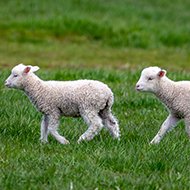
Temperature fluctuations are making hatching difficult to predict, says SCOPS.
Vets and farmers are once again being advised to make use of the Sustainable Control of Parasites in Sheep (SCOPS) Group forecast tool to identify when lambs might be susceptible to nematodirus.
Independent sheep consultant Nerys Wright says: “The SCOPS Nematodirus Forecast is an essential tool due to the role of temperature on the larvae of this worm species. This year in particular we have seen some significant fluctuations in temperatures, making the time of hatching difficult to predict without the forecast.
“Currently, the map indicates there are some very high risk areas, as marked by black dots, which is earlier than in previous years. Lambs born from mid-February onwards that are old enough to be grazing are currently at the highest risk. Most March-born lambs are currently too young to be affected.”
Analysing forecast data from 2019 to 2024, SCOPS show how temperature fluctuations influence the timing of the nematodirus hatch. Their study reveals variations in the very high-rise periods for two weather stations, one in England and the other in Scotland.
Dr Wright adds: “The range between the earliest and latest onset of very high-risk varies by six to seven weeks over a five-year period, highlighting that treatment at set times is unlikely to be effective.
"Neither can we risk a wait-and-see approach because when an outbreak occurs, as Nematodirus can rapidly cause severe harm or even death to a large number of lambs. The forecast helps to pinpoint the timing of any treatment given.”
The SCOPS forecast uses local weather conditions to predict the hatching of nematodirus larvae. The interactive map is updated every day with data from 140 weather stations to provide a guide to the risk level throughout the UK.
Image (C) Shutterstock.



 BSAVA is to partner with BVA Live (11-12 June 2026) to champion clinical research.
BSAVA is to partner with BVA Live (11-12 June 2026) to champion clinical research.